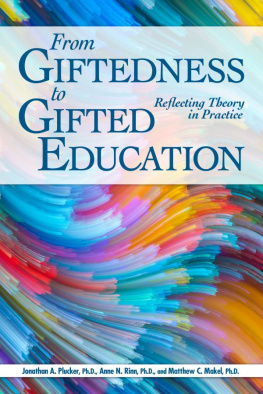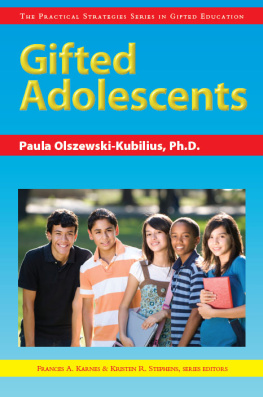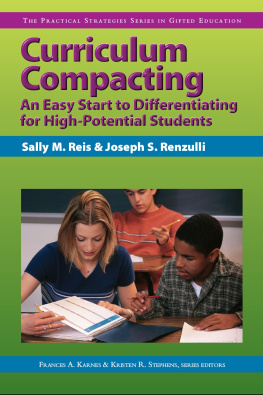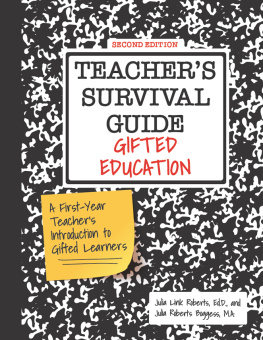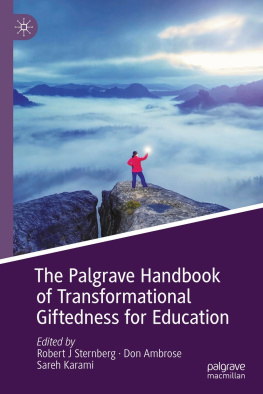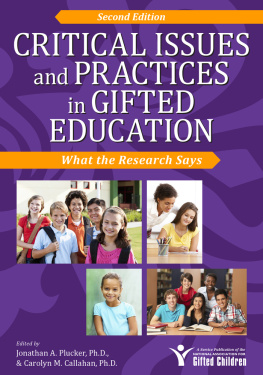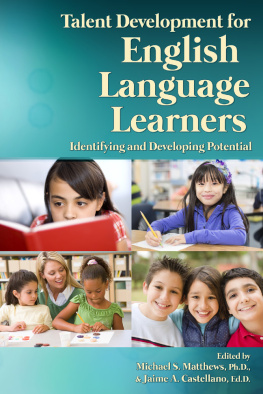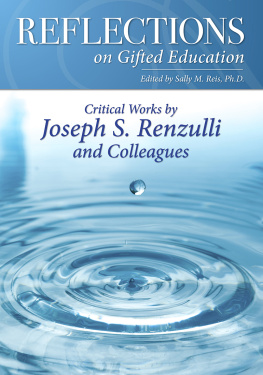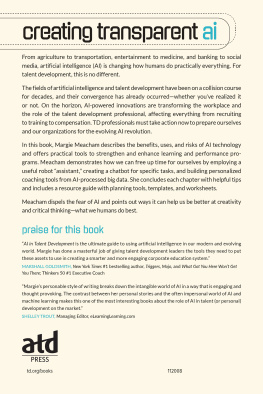


DEDICATION
For Peni and Steve Plucker and Kay and Tom Whitman, who have supported me, my work, and my family unconditionally.JAP
For my parents, Randy and Carol Rinn, who were my first teachers and the hardest working people Ive ever known. Dad, enjoy your retirement!ANR
For Mrs. Sandy Strobel Johnson and Mrs. Pat Gabriel, who taught me when I was young and whose passion and dedication inspire me to help those who are young now.MCM
Library of Congress catalog information currently on file with the publisher.
Copyright 2017, Prufrock Press Inc.
Edited by Lacy Compton
Cover design by Raquel Trevino and layout design by Marjorie Parker
ISBN-13:978-1-61821-708-0
No part of this book may be reproduced, translated, stored in a retrieval system, or transmitted, in any form or by any means, electronic, mechanical, photocopying, microfilming, recording, or otherwise, without written permission from the publisher.
For more information about our copyright policy or to request reprint permissions, visit http://www.prufrock.com/permissions.
Printed in the United States of America.
At the time of this books publication, all facts and figures cited are the most current available. All telephone numbers, addresses, and websites URLs are accurate and active. All publications, organizations, websites, and other resources exist as described in the book, and all have been verified. The authors and Prufrock Press Inc. make no warranty or guarantee concerning the information and materials given out by organizations or content found at websites, and we are not responsible for any changes that occur after this books publication. If you find an error, please contact Prufrock Press Inc.

| Prufrock Press Inc.
P.O. Box 8813
Waco, TX 76714-8813
Phone: (800) 998-2208
Fax: (800) 240-0333
http://www.prufrock.com |
Table of Contents
Introduction
Jonathan A. Plucker, Anne N. Rinn, and Matthew C. Makel
M eeting the needs of advanced students has a long history in the United States (Robinson & Jolly, 2013). In 1868, the superintendent of St. Louis schools began a program specifically dedicated to serving students who were able to accelerate through the elementary grades more quickly than their peers. Indeed, acceleration was the most common approach to serving bright children in the late 1800s and the early 1900s in the United States. But, over the past 150 years or so, how best to identify and serve gifted students has remained a constant, controversial question for researchers, practitioners, families, and policymakers. And, in that 150 years, numerous perspectives have been offered.
More recently, the field of gifted education and talent development has experienced a range of conceptual and instructional advances, moving the field to a point of conceptual richness and diversity that would have been hard to imagine even 15 years ago. However, despite a large number of books on the topics of gifted education and talent development, we could not find a single resource collecting each of the various approaches to serving gifted and talented students. Although there are high-quality books focusing on conceptual perspectives or systems and models perspectives, the combination of both perspectives is generally found only in introductory textbooks, which by necessity also include a range of other topics. This limits the space for discussion of how our theories and conceptions connect to practical application. And, in a field like gifted education, practical application is paramount.
Broadly speaking, the importance of evidence-based practices in gifted education cannot be overstated, but the actual practices being used in schools are often not evidence-based (e.g., 30 minutes a week in a pull-out program is likely not the most effective educational intervention available, despite being quite common). This implementation gap is closing, but we are in the midst of a long journey in this regard. In an effort to contribute to closing the implementation gap, we wanted to create a single volume that provided readers with the information needed to explicitly connect the conceptual and practical perspectives. Various views of giftedness and talent may be separated by common language, relying on different terms, combined different ways, but converge on a fairly unified vision of how to identify and serve gifted and talented students. With this shared destination envisioned, it is largely up to us to make reflecting theory in practice a reality so that we can best serve gifted and talented individuals.
SELECTION OF AUTHORS AND TOPICS
We sought to provide a comprehensive summary of major models and conceptual directions in the field of gifted education and talent development with ample descriptions of their potential application. We started by identifying the conceptual work that appears to be most widely discussed in the field, then attempted to identify new and emerging perspectives that could soon grow to hold an important place in the field. Finally, and with a bit of a twist, we included major intervention strategies, with the intent of having authors work backward, in a way, to discuss the conceptual and empirical foundations of popular interventions, such as acceleration and grouping.
Although we strove to be comprehensive, we readily acknowledge that other important perspectives existthe book could only be so long! In addition, a few major thinkers were not able to write chapters, and a couple of chapters were not submitted in time to be included. Regardless, we believe the coverage in this book offers readers a strong foundation for examining how theory can, should, and often does become reflected in our practices.
Selecting authors for each topic was straightforward. For example, George Betts was asked to write about his Autonomous Learner Model, Joe Renzulli and Sally Reis were asked to write about their work, and Franoys Gagn was invited to describe his model and its application. The work of such authors introducing their own ideas once again constitute the majority of the book, and we are grateful for their quick, enthusiastic responses. For other, broader chapters, we invited people we consider to be authoritative thinkers on important topics related to gifted education and talent development (i.e., our colleagues from the Belin-Blank Center wrote about acceleration). We should note that the turnaround time for authors was almost unreasonably short. Authors had roughly 4 months from invitation to the revision deadline to submit their chapters in highly polished form. Our enthusiasm for this book is based in large part on the quality content that our colleagues provided, for which we are appreciative.
ORGANIZATION OF EACH CHAPTER
We invited authors to write chapters that address three questions from their perspective, with the responses to the second and third questions getting the lions share of attention in each chapter. First, we asked authors to define from their (theoretical/conceptual) perspective, what does it mean to be gifted/talented? We also asked them to include a brief description of their definition of giftedness/talent/ exceptional performance. Second, we asked the authors to describe how individuals develop gifts and talents according to their conception. Third, we asked authors to outline how they would ideally advise educators to develop their students gifts and talents. Further, if practitioners have implemented their approach, what research support regarding the efficacy of those efforts exists? Essentially, we wanted authors to introduce their definition upfront, discuss their conceptual/theoretical approach, and then examine how each approach can be put into practice.
Next page
